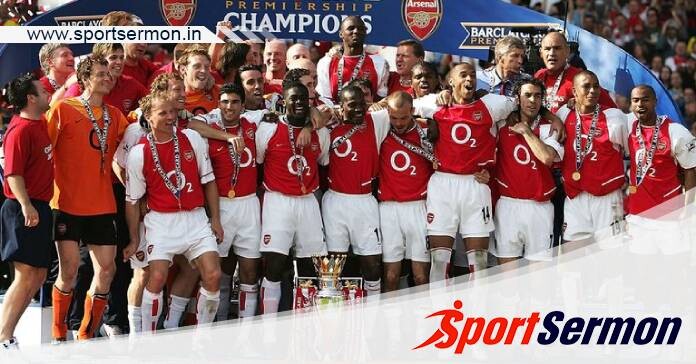One thing jumps out at you the moment you look at the final Premier League table for the 2003–04 campaign. If you didn’t know the incredible tale of Arsene Wenger’s Arsenal in the early 2000s, you might mistakenly believe that a “0” in a “losses” column was an editing error. However, in going undefeated for 38 games, that renowned Arsenal Invincibles squad defied their doubters, every Premier League team, and common sense itself.
They have left a lasting impression on English football history and played some of the best football ever witnessed on these shores. This article will examine the players who contributed to this incredible feat, how they worked within Wenger’s ground-breaking tactical scheme, and some of the key individuals behind their unstoppable victory.
Up until recently, it appeared absurdly unlikely that another squad could go undefeated. However, the current dominance of Manchester City and Liverpool has observers wondering if history will repeat itself. Naturally, only Liverpool has not lost this season. Six losses already for Manchester City, which is twice as many as they had all of the previous campaign. However, based on their present performance, Jurgen Klopp’s team appears to have a remote chance of matching the undefeated. They would most likely score more points if they were able to accomplish this.
The Porto team that included James Rodriguez and Jackson Martinez in the 2012–13 Primera Liga season was undefeated in previous years. As did Celtic, led by Brendan Rodger, in the Scottish Premier League of 2016–17. However, Juventus is the only other side to have done so in the previous 25 years among the teams that compete in the so-called “Big Five” leagues (Premier League, Serie A, La Liga, Ligue 1, Bundesliga). Find the Arsenal Invincibles squad below.
Arsenal 03-04 The Invincibles Starting XI
Goalkeeper – Jens Lehmann
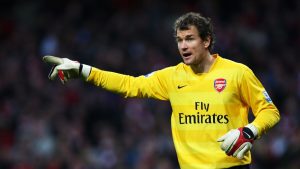
Jens Lehmann, a new addition to the team in the 2003–04 campaign, replaced David Seaman in the Arsenal lineup. He would go on to play for Arsenal for five seasons, totaling 199 games. He decided to leave to rejoin VfB Stuttgart in his native Germany. But Lehmann made a round 200 comeback to London in the 2010–11 season. He playing just one game for the Gunners before hanging up his gloves. Lehmann was the ultimate wind-up merchant, a superb shot-blocker who had good area control. He exuded pandemonium as many goalkeepers do. However, he was inconsistent at times, a quality that ultimately caused Arsenal to fire him.
Right back – Lauren
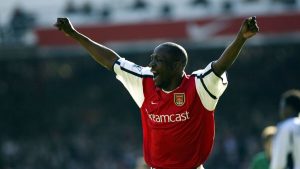
For Arsenal in the 2003–04 Premier League season, the pragmatist Lauren started 32 of the team’s 38 games. After joining the team at the beginning of the year after leaving Mallorca, it was his fourth season there. Lauren, like Lehmann, took the position of an Arsenal icon in the starting lineup. He replaced Lee Dixon, who played for Arsenal for 15 seasons and made over 600 games. Although it was a daring choice, the manager would not look back.
The time Lauren became one of the players from the Arsenal Invincibles squad to yell at Ruud Van Nistelrooy after the Manchester United forward missed a late penalty in their match known as the “Battle of Old Trafford” is arguably his most memorable moment while wearing an Arsenal shirt. In the end, this error proved to be crucial to Arsenal’s success in staying unbeaten.
Center Back – Sol Campbell
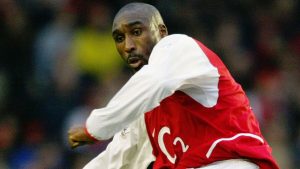
A large portion of the British media severely criticized Sol Campbell when he joined Arsenal in 2001 from bitter rivals Tottenham Hotspur. They had no way of knowing, however, that it would be a choice that would make him a legendary figure at Arsenal, one that would also prove to be fully justified.
During his nearly ten years as a player with Spurs, he won one championship—the Football League Cup in 1999. During his five-year tenure at Arsenal, Campbell became an indispensable member of the England back four, winning two Premier League titles, two FA Cups, and making an appearance in the Champions League final. Campbell featured in all but three of Arsenal’s 38 games during the 2003–04 season, tallying two goals.
Center-Back – Kolo Toure

At the time, Kolo Toure was among the youngest players in the senior professional roster at Arsenal, but he was also one of the most reliable. The Ivorian joined the Invincibles as a regular back-line member when he was barely 22 years old. In only his second season as a professional football player, he was already creating history.
Overall, during the 2003–04 season, the youthful Ivory Coast international missed just one game and received a ton of plaudits for his explosive center-half performances. In the process, he established himself as a resolute defender who was also a thrilling ball player and technically sound. Toure would go on to play for Arsenal, Manchester City, and Liverpool in the Premier League for 353 games, winning the FA Cup twice and the Premier League once.
Left-back – Ashley Cole
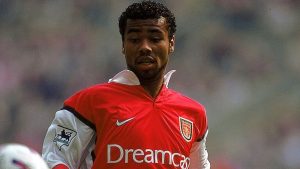
Ashley Cole, who was just a year older than Kolo Touré, was another young player who brought some energy and enthusiasm to Arsenal’s starting eleven, which was primarily composed of veterans, worldly-wise, and experienced players. Even at such a young age, Cole had been a fixture at Highbury for a number of years prior to the legendary 2003–04 campaign. A few years prior, in 2001–02, he started to establish himself as the team’s starting left-back and enjoyed his breakthrough season.
Cole would eventually make a contentious transfer to Chelsea, earning him the unfortunate moniker “Cashley Hole” from Arsenal supporters. Whether he is a money-grabber or not, Ashley Cole is unquestionably one of the greatest left-backs the English game has ever seen due to his fundamental skill.
Right-Midfielder – Freddie Ljunberg
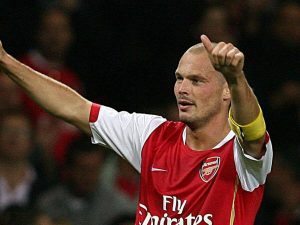
Before his brief time as the team’s manager, Freddie Ljungberg, then just 19 years old, signed with Arsenal in 1998 as a relatively unknown young player from Halmstad. The Swede would play almost two decades of league appearances for Arsenal in little under a decade. He won six championships and scored 46 goals during the glittering golden age of the team. Ljungberg had one of his greatest seasons with the team in 2003–04. He appeared in 30 league games and tallied four goals. Regretfully, in the manager’s chair at Arsenal, the mysterious Scandinavian was unable to duplicate the success of his playing career.
Centre-Midfield – Patrick Vieira

The first name on this list to have achieved true global superstar status by the time of the 2003–04 season is Patrick Vieira. By the time he emerged as maybe the most important member of the Invincibles lineup. He already had two Premier League medals, two FA Cups, a European Championship, and a World Cup in his bulging trophy cabinet. In his penultimate season as an Arsenal player, Vieira led the team to a historic victory as a dominant presence in the middle of midfield.
Violent in the tackle Though many English managers had used Vieira as a hatchet man in the past. Arsene Wenger saw something different in him. In a box-to-box role, Vieira stopped opposition assaults and initiated his own by pushing the ball or laying off a beautiful pass to a teammate. The Frenchman is a genuine legend of the Premier League and Arsenal.
Centre-Midfield – Gilberto Silva
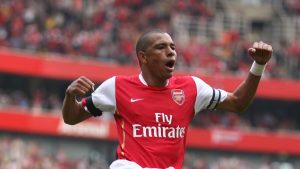
Gilberto Silva, who played a nearly equally important role in the Arsenal Invincibles squad as the Frenchman, supported Vieira in the middle of the field. More of a defensive man, Gilberto Silva was a regular source of consistency for the back four. He covered for Vieira when he made one of his signature runs up the pitch.
Gilberto Silva left Atletico Mineiro, where he was a member of the team that won the Copa Libertadores. He signed for Arsenal in the 2002–03 season. Unusually for a young player from a non-European footballing background, he made 35 Premier League appearances in his debut season after jumping right into the first squad. He made 32 appearances, scored four goals, and cemented his place in Arsenal history in 2003–04.
Left-Midfield – Robert Pires
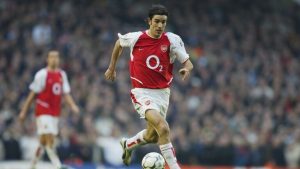
One of these amazing Arsenal 11’s most creative and emotionally charged players was Robert Pires. This is due to his propensity for spectacular goals and his sophisticated, creative style of playing the beautiful game. He could play practically anywhere in midfield or in the forward line. His primary position on the field was left midfield. Wenger has great faith in his compatriot and lucky charm. Pires’ fourth season at Arsenal came in 2003–04, and it was arguably the best of his illustrious athletic career. In 189 Premier League games for Arsenal, Pires scored 62 goals in total. 14 of which came during Arsenal’s undefeated championship run.
Centre-Forward – Dennis Bergkamp
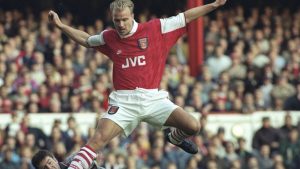
Another name connected with Arsenal in their wonderful heyday is Dennis Bergkamp. He was nicknamed the non-flying Dutchman because of his severe dread of flying. Throughout their unbeatable season, he scored four goals—not bad for a striker, you might think. However, Bergkamp’s strategy in the Arsenal Invincibles squad was far more significant than his goal totals. Rather than playing as a traditional number nine, he was more of a “second striker”.
During his ten incredible seasons with the Gunners, the Dutchman scored 89 goals in 315 appearances. Bergkamp, who was 33 years old at the time, was the oldest player in Wenger’s preferred starting lineup. After winning ten trophies with the team, he put up his boots after two seasons. In his likeness, there is a statue outside the Emirates Stadium.
Striker – Thierry Henry

Finally, but certainly not least—quite the contrary, in fact—is the formidable Thierry Henry. With 30 goals in the 2003–04 Premier League season, the Frenchman was Arsenal’s top scorer ever and had one of his greatest seasons personally. With good cause, he is arguably the one player that the Arsenal supporters adore the most. He created 74 assists and scored 175 goals in 258 Premier League games. It gave him an amazing goal/assists ratio that was just under 1.00.
On the pivotal day of the Premier League title battle in 2004, Henry scored the equalizer before Vieira scored the winner. Despite his preference for more visually spectacular goals, his contribution encapsulated his very significant role in the Arsenal team: poise, class, and ability.
Arsene Wenger’s Tactics
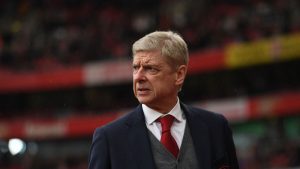
Arsenal started with what could appear to be a conventional 4-4-2 formation. It was a scheme that had been employed in England for decades. It has only really fallen out of favor in the last 5-8 years. Not really a revolutionary system, is it? That was, indeed, a 4-4-2, but not quite. Dennis Bergkamp, as previously said, dropped in behind Thierry Henry and played more of a free role in the Arsenal Invincibles squad rather than playing with two forwards on the pitch. the kind that Barcelona’s Lionel Messi has consistently displayed throughout the years. Bergkamp made sure that Arsenal would always be unpredictable by doing this. Would they be using a 4-4-2, 4-5-1, 4-2-3-1, or 4-4-1-1 formation? This made it more difficult for the already famous opponents to be ready for the intimidating matchup with Arsene Wenger’s side.
Because Ljungberg and Pires, two wide midfielders, played more like inside strikers when attacking. Arsenal was extremely powerful when counterattacking and could clear the ball to the wings. Originally from France, Thierry Henry was a left-winger by trade. He was also a skilled wide player who could play as much as a striker. Furthermore, Arsenal had a more direct path to goal if deft interplay on the wings and in the forward areas was not yielding results because Patrick Vieira was able to shine when bursting forward with the ball thanks to the cover Gilberto Silva provided in midfield and Kolo Toure’s comfort level in high-pressure situations. This implied that opportunities to score goals came from everywhere.
That explains the attacking side, but Arsenal’s defense was the true reason they didn’t lose any games in 2003–04. The team didn’t use the rock-and-roll press, which is a common practice among teams these days. Additionally, the squad wasn’t positioned to want to win the ball back while the opposition was in their half. Rather, they were content to play defense as two strong banks of four, keeping cunning players from breaking their lines.
For more football news, click here

